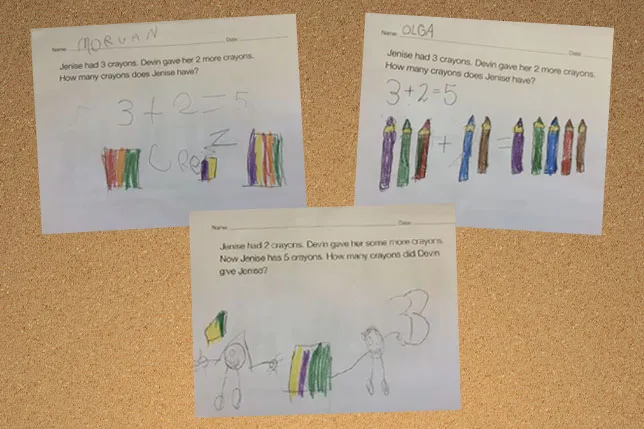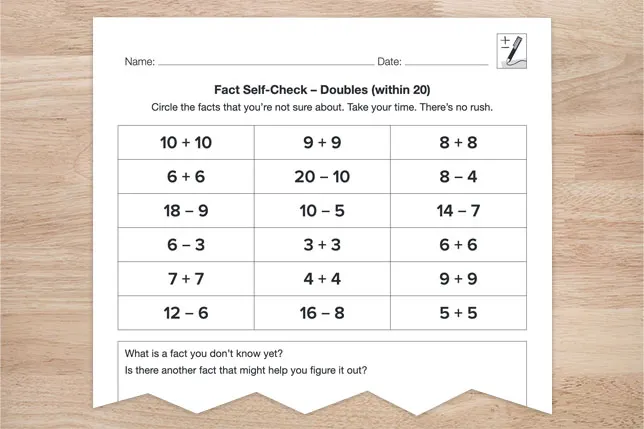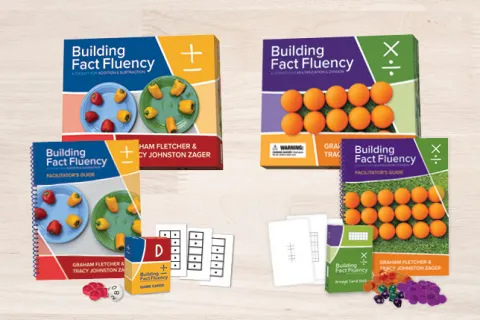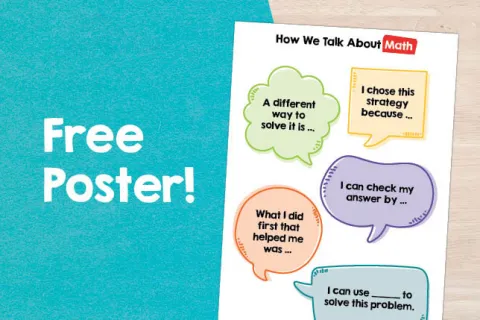
3 Ways to Assess Math Fact Fluency

“Fluency,” in elementary school, typically refers to students’ ability to perform a skill quickly, accurately, and effortlessly. A student with fluency is often said to simply know the skill. When it comes to math facts—the basic addition, subtraction, multiplication, and division calculations, such as 6 + 4 = 10 and 9 ÷ 3 = 3—experts emphasize that fluency is more than just speed and accuracy.
What Is Math Fact Fluency?
Building Fact Fluency co-authors Graham Fletcher and Tracy Johnston Zager offer a helpful definition of math fact fluency. They emphasize that students not only know but also can use their math facts.
Fact fluency means students know and can use their facts.
—Graham Fletcher & Tracy Johnston Zager
Graham and Tracy echo many of the words commonly used to define fluency in other contexts—including accurate and efficient—but they and other math experts add the word flexible.
In the context of math facts, we know that accuracy means students can find the right answer. When a student says, “8 + 9 = 17,” they are accurate. They might have modeled it, used a count all or count on strategy, used a fact they knew to figure this one out, or retrieved the sum from memory.
Efficiency in this context means students can solve problems with a strategy that saves time or labor. Instead of counting all 17 in the example of 8 + 9, for example, a student might count on from the bigger number: “9, 10, 11, 12, 13, 14, 15, 16, 17.” Or a student might use double 8 to solve the problem: “I know 8 + 8 = 16, so 8 + 9 is 1 more. It’s 17.” Or a student might say, “I just know that one. I remember it.”
Flexible in this context means students know multiple solution paths and can choose an appropriate strategy for a given problem. For example, a student might notice the problem 8 + 9 involves a 9, so they decide to make a 10: “I like 10s. Nine is close to 10, so I took 1 from the 8 and gave it to the 9, so it became 7 + 10. That’s 17.” A student with flexible thinking would use a different strategy for 15 + 3.
Historically, students memorized math facts—often using flash cards to help—and then moved on to problem solving. But research tells us that fluency should be an outcome of problem solving in math class, not a prerequisite for it.
Why Doesn’t Rote Memorization Improve Fact Fluency?
Memorization might enable some students to become fast and accurate with their math facts, but it doesn’t teach them anything about flexibility. The only strategy they have for solving the equation is memorization. . . they know it or they don’t.
Memorizing facts for recall with flashcards or on a timed test also doesn’t seem to transfer to problem solving. Have you ever seen a student who can answer all their math facts correctly on flashcards revert to counting on their fingers when solving a word problem? They aren’t applying what they learned in one way to a different situation. The knowledge didn’t transfer.
The same can happen between a number talk and problem solving. . . students may understand a strategy in the number talk but forget to employ it when they’re working independently on problem solving. Students often need the context of the problem to discover, understand, and eventually transfer the strategy to another context.
How Can We Assess Math Fact Fluency?
Given the importance of problem solving, we can look for ways to assess fact fluency as students solve problems. What might that look like? In answer to that question, Graham Fletcher reminds us that the word assessment is derived from the Latin verb assidere, which means “to sit beside.”

Assessment by Observation
The great thing about contextualized problem solving is that it provides us an opportunity to observe students’ thinking process. Molly Rawding, math specialist at Lexington Public Schools in Massachusetts, told us about her observation of a kindergarten class working through the first lesson string in Building Fact Fluency: A Toolkit for Addition and Subtraction. Students had completed an Image Talk looking at crayons and then a Tool Talk, and now were looking at a contextualized problem:
Janice has three crayons, and Devin gave her two more crayons. How many crayons does Janice have?
Because it was a kindergarten class, Molly started by talking about the problem, helping students visualize it and even acting it out a bit, before sending students back to their seats to work independently. How could you show a picture to figure out the answer. . . show what you’re thinking as you solve this problem?
Students went to their seats and started drawing pictures. . . some were of crayons. . . some were simple sticks or dots. . . some even included Janice and Devin. Molly sat by a group of students and watched them. What was their first move? What did they put on paper as their first thinking? Was it the numbers? Pictures? Was it some sort of annotation in a different way?
After students worked independently, Molly invited them to share their work and their thinking with others at their table. This led to whole-class conversation about different ways of thinking about the problem and solving it.
Molly captured her observations that day with simple notes on a single-page chart that contained every student’s name in one column. She noted who she observed, who she invited to share with the whole class, and what she saw happening (e.g., counting, counting on, tally marks, etc.) Because she kept a record of her formative assessments, she can look for trends to inform additional instruction. She has a record of the strategies students used to solve the problem, which gives her an idea how much flexibility they are developing.

Assessment by Follow-Up Interview
Ashley Powell, K–12 math coach at Cobb County School District in Georgia, gathers similar formative assessments from interviews with students. She saw student work, for example, where the visual representation didn’t exactly match the story in the problem. Ashley was immediately curious about the students’ thinking.
The problem described four boxes each containing five crayons, but one student drew five boxes with four crayons each. Rather than marking the problem wrong or making assumptions about the student’s thinking, Ashley asked follow-up questions the next day.
When explaining their approach to the problem, the student acknowledged that they intentionally drew a picture that was different than what was stated in the problem because they knew the commutative property and thought it was easier to count by fives than by fours. The one-on-one interview enabled Ashley to describe what the student knew instead of focusing on something that might have looked like a mistake. The student displayed flexibility and accuracy!
Assessment by Self-Check
Observing how students go about solving a problem and asking them to say more about the thinking that is visible on their work page are helpful ways to measure what students know about their math facts. Building Fact Fluency co-authors Graham and Tracy also encourage teachers to engage students in their own fact fluency assessments.
“Students tend to be very honest about what they know and don’t know, especially in classrooms where growth and learning are valued,” explains Tracy.
Graham and Tracy use Fact Self-Check recording sheets to engage students in their own assessments. The sheets can be tailored to reflect facts relevant to recent lessons. Students simply identify the facts they aren’t sure they can answer accurately. Students don’t have to write answers to the math facts and, unlike a timed test or “mad minute,” they can take as much time as needed.

After students mark the facts they don’t yet know, the teacher asks, “Is there another fact that you do know that might help you figure out the ones you don’t know?” This intentional question helps students start deriving facts rather than always counting on or skip counting and thinking additively.
Teachers use these Self-Checks in different ways, not always asking students to consider the whole document, for example. A teacher might say, “Look at the first column of math facts. Are there any there you’re not sure about?”
Or perhaps pick out a handful to ask during a 1:1 conference with a student. “What’s 10 + 10? . . . How do you know? . . . What about 18 – 9? . . . Do you know another fact that could help you figure it out?”
This provides quick feedback—another assessment snapshot that, together with other measures, provides a more accurate sense of students’ fluency development.
Building Fact Fluency Toolkits
Ready to see firsthand how real-world contexts and problem solving can build students’ fact fluency? Graham Fletcher and Tracy Johnston Zager are co-authors of Building Fact Fluency toolkits featuring ready-to-use images, tools, activities, tasks, and games that help students explore strategies and factors.
You May Also Like


